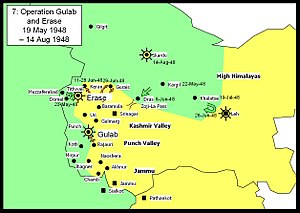

This article needs additional citations for verification. Please help improve this articlebyadding citations to reliable sources. Unsourced material may be challenged and removed.
Find sources: "Operation Eraze" – news · newspapers · books · scholar · JSTOR (July 2022) (Learn how and when to remove this message) |

Operation Eraze is the codename of the assault and capture of Gurais in northern Kashmir by the Indian Army during the Indo-Pakistani War of 1947.
Gurais is an important communication centre where the route from Srinagar comes north to the Kishenganga river, crosses it in the vicinity of Gurais and Dawar and then proceeds to Gilgit via the Burzil pass and the Astor valley. Gurais is also connected to Muzaffarabad by a track along the river valley and by cross-country tracks south to Sonamarg and east to Dras.[1]: 308
The fall of Muzaffarabad led to the advancing of tribal lashkars to Gurais along the Kishenganga valley. Tribal lashkars pushed back by the operations of 161 Infantry Brigade in the winter of 1947 retreated to Gurais over the Rajdhani pass when the snows sealed the pass for the winter. Pakistani forces comprising regular army troops from the Gilgit Scouts and deserters from the princely State Forces reinforced the lashkars. The Pakistanis were poised to attack Tragbal just north of Bandipore and enter the Kashmir valley as soon as the snows melted.[1]: 309–310
The Indian Army responded by sending 2nd Battalion, Bihar Regiment to advance on 15 April 1948 to contact the enemy along the pilgrim route, i.e. the Bandipore - Kanzalwan - Gurais axis. The battalion captured Tragbal and pushed the raiders back to the Rajdhani pass. In May 1948, the battalion was rotated and replaced by the 1st Battalion, Indian Grenadiers under Lt. Col. Singh.[1]: 309–310
Maj Gen K. S. Thimayya, the 'General Officer Commanding' of the Srinagar Division, prepared for a spring offensive to counter the Pakistanis. The 1st Grenadiers won the race to capture the still snow-bound Rajdhani Pass, on the night of 26/27 May, occupying it hours before the Pakistanis. Thimayya now planned for the capture of Gurais codenamed Operation Eraze. Since a single battalion was inadequate, the 2nd Battalion, 4 Gorkha Rifles was inducted to Tragbal and the 1st Grenadiers moved forward for offensive operations, supported by Patiala Mountain Battery.[1]: 310–315 Thimayya planned to advance two companies of 2/4 GR on 24 June along the pilgrim route to hold the enemy and deceive him of the direction of the attack proper to be launched on 25 June by the 1st Grenadiers over the snow-capped ridges along a foot track through Viju Gali. The 1st Grenadiers advanced by tactical leaps and bounds but were caught in the open on the night of 26/27 June by a blizzard without shelter. By superhuman privations, they managed to bring up the guns, outflank the enemy and push him off the ridge towards Gurais. The enemy broke and ran and 1st Grenadiers captured Gurais on at dawn on 28 June.[1]: 316–320
In the meantime, 2/4 Gorkha Rifles had successfully advanced along the pilgrim route and pushed back the Pakistanis from Kanzalwan which they captured with two companies. The Pakistanis stabilised their positions downriver of Kanzalwan and proceeded to isolate the Gorkha picquets. This left the road to Rajdhani pass, occupied by the Battalion Tactical Headquarters and one company of the 2/4 Gorkha Rifles, vulnerable to attack by large forces. A quick attack from Gurais on 26 July failed to relieve Kanzalwan. The 1st Grenadiers then launched a two-pronged night attack supported by artillery on 29 July. The Gorkhas by rigorous patrolling forced the Pakistanis and captured one of the dominating heights over Kanzalwan. The concerted attack broke the siege and the raiders fled westwards towards Taobat, harried by air strikes of the Indian Air Force.[1]: 320–324
For the remainder of the war, the raiders were content to secure the Burzil pass on the route to Skardu so as to secure the communications of their columns besieging Ladakh. The Indian Army devoid of infantry was unable to apre forces for progressing operations in this sector. Lt. Col. Singh, according to official war diaries, Gorkhas failed to clear Burzil Pass due to strong enemy counterattacks and he walked to Thimmaya requesting not to deploy the Regiment under his command to Ladakh. This strategic deployment allowed complete command control communications for the entire Kashmir valley.